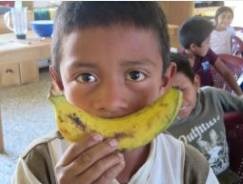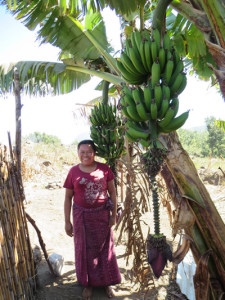 Bananas really are amazing. They are the perfect nutritious snack food wrapped in their own sanitary packaging. They have 110 nutrient-dense calories and are pure and safe enough to be a baby’s first solid food.
Bananas really are amazing. They are the perfect nutritious snack food wrapped in their own sanitary packaging. They have 110 nutrient-dense calories and are pure and safe enough to be a baby’s first solid food.
Bananas are low in fat, cholesterol-free and a good source of potassium, dietary fibre and magnesium, as well as Vitamins B6 and C.
The residents of Chuk Muk, Guatemala are incredibly fortunate that this power food grows in their sub-tropical climate. If the village had a slightly higher altitude and was not situated on a lake, they would not be able to grow bananas.
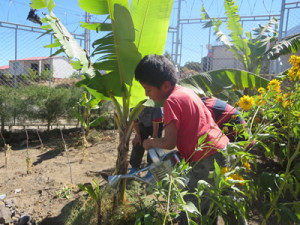 In Chuk Muk village, the majority of the families live in abject poverty. The few coins they earn are used to purchase corn to make tortillas. When children snack, the families usually buy sugary sweets as they are incredibly cheap and stave off hunger. Unfortunately, this practice does nothing to help a child’s nutritional status and results in increased incidence of dental caries.
In Chuk Muk village, the majority of the families live in abject poverty. The few coins they earn are used to purchase corn to make tortillas. When children snack, the families usually buy sugary sweets as they are incredibly cheap and stave off hunger. Unfortunately, this practice does nothing to help a child’s nutritional status and results in increased incidence of dental caries.
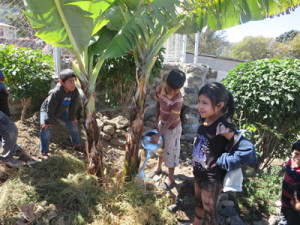 Aldea Maya, a non-profit grassroots organization working in the Lake Atitlan area of the Guatemalan highlands, is using school-based interventions to positively affect the cycle of poverty. We targeted Grade 2 classes to implement our Banana Project. Our goal is to empower children, through knowledge, to make healthy food choices.
Aldea Maya, a non-profit grassroots organization working in the Lake Atitlan area of the Guatemalan highlands, is using school-based interventions to positively affect the cycle of poverty. We targeted Grade 2 classes to implement our Banana Project. Our goal is to empower children, through knowledge, to make healthy food choices.
Our first step was to teach the children about the care of plants, specifically banana plants. The students learn that they need to add chicken poop and wood ash to the banana’s soil. They also need to water the leaves and roots on a daily basis.
Each of the three Grade 2 classes was responsible for the maintenance of the school’s banana plants for six weeks.
The next step was teaching the students interesting nutrition facts about bananas.
Bananas are also great if you have diarrhea, a very common occurrence in third world countries.
We used student interaction and visual aids wherever possible. This method is working, as a year later the students still know how bananas help their body.
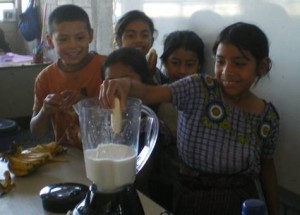 Another fun activity is our cooking classes. The students help to make a banana smoothie. For the majority of students, it is their very first smoothie and it is a huge treat. As sanitation is also very important, we stress hand washing and proper cleaning of equipment.
Another fun activity is our cooking classes. The students help to make a banana smoothie. For the majority of students, it is their very first smoothie and it is a huge treat. As sanitation is also very important, we stress hand washing and proper cleaning of equipment.
To effect long standing change, not only do the students need to understand the importance of nutrition, but healthy foods must also be affordable. To facilitate this process, Aldea Maya purchases banana plants and organic compost for every student in Grade 2.
In the last five years, over 400 banana plants have been distributed in Chuk Muk. It costs $2.40 per student to purchase the banana plants, organic compost and smoothie ingredients. In 2015, we are expanding our classes to include mothers in the village.
 Anyone wishing to contribute to our nutrition and garden projects, please visit our website. We are a registered Canadian charity and donations receive a tax receipt.
Anyone wishing to contribute to our nutrition and garden projects, please visit our website. We are a registered Canadian charity and donations receive a tax receipt.
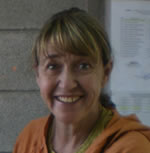 Louise Sosa
Louise Sosa
Aldea Maya
Website
Email
See all articles by Louise Sosa





